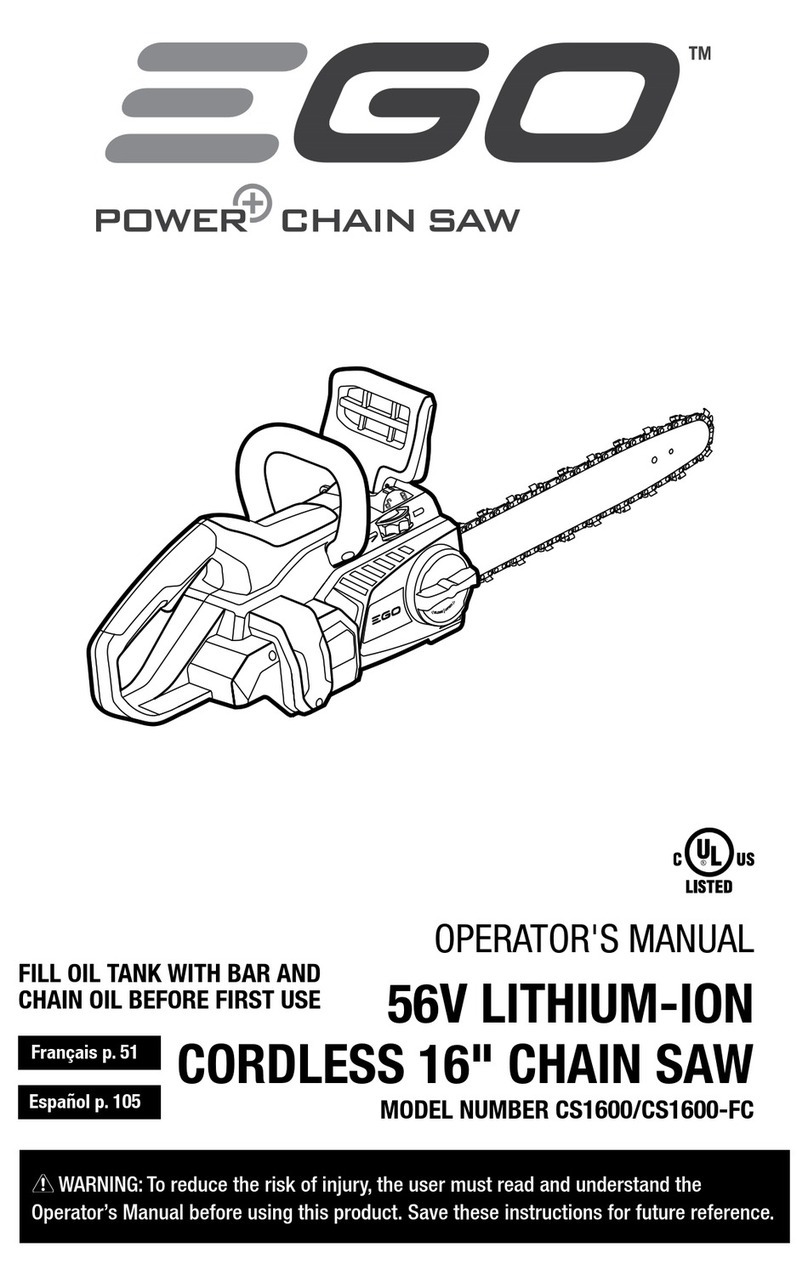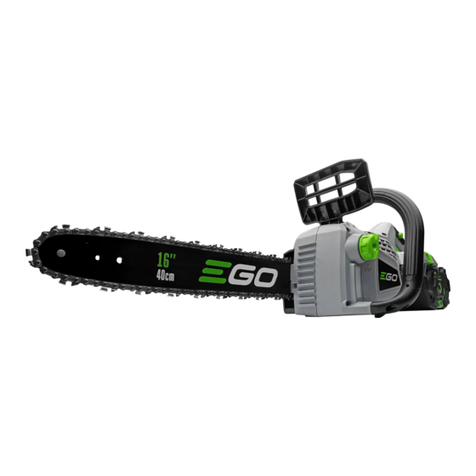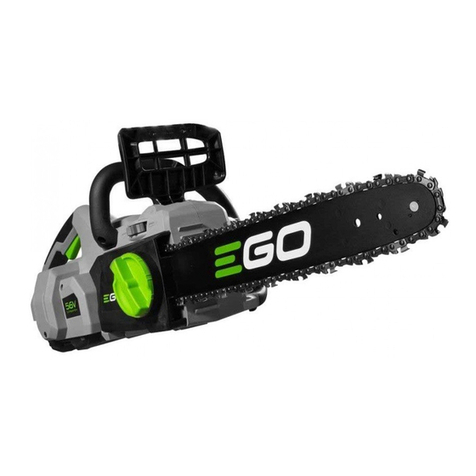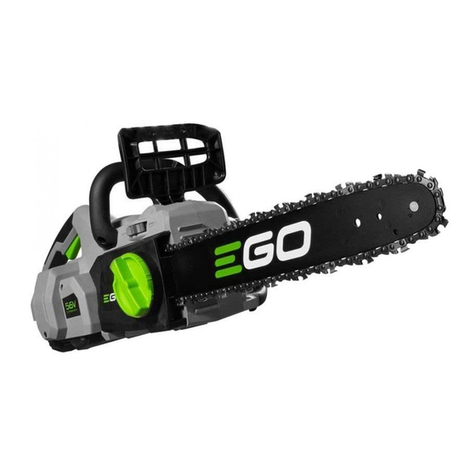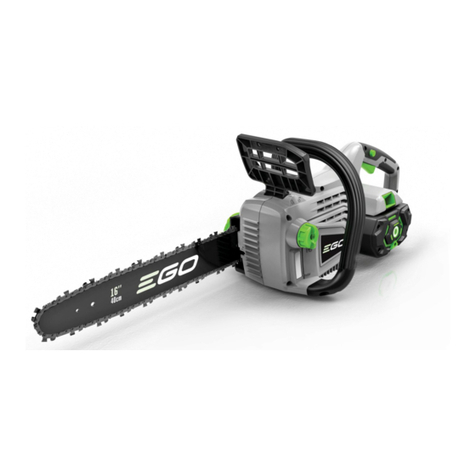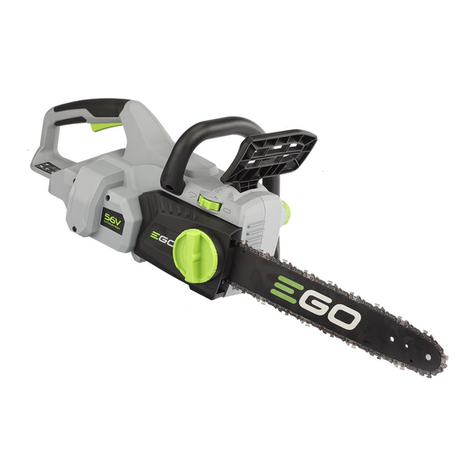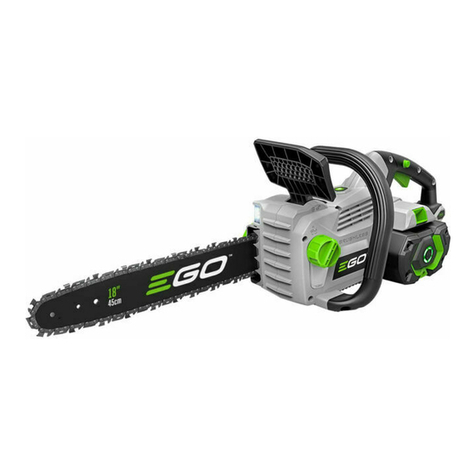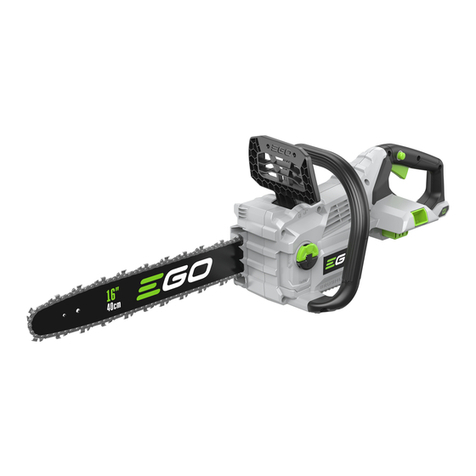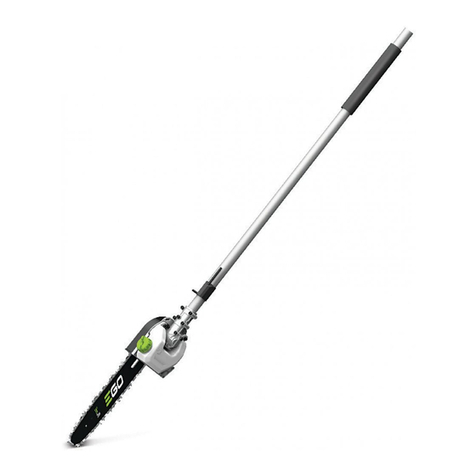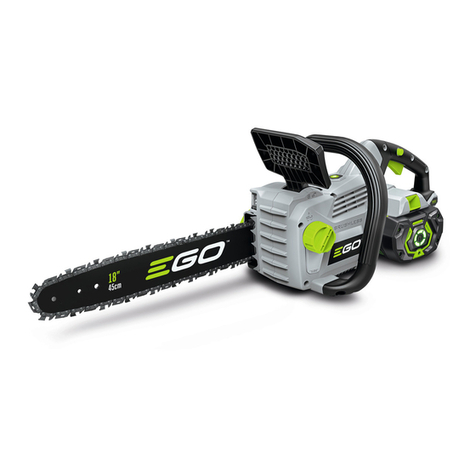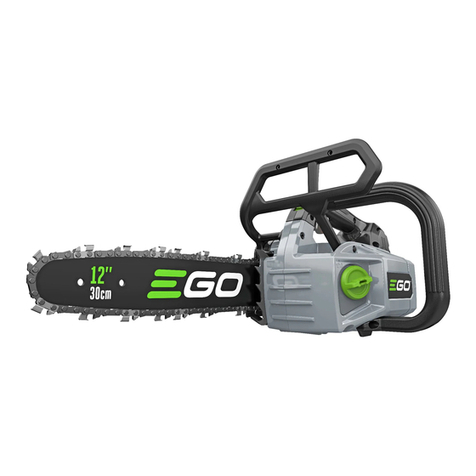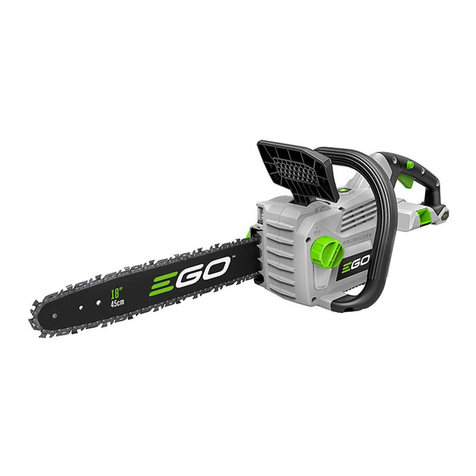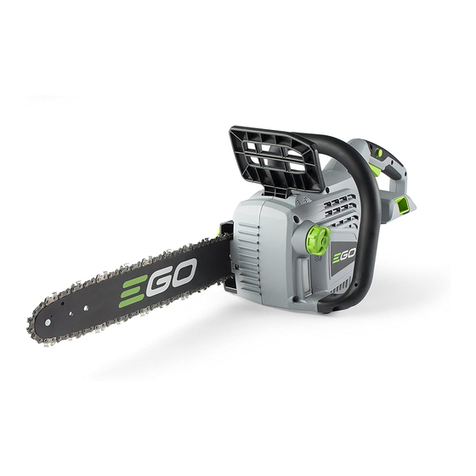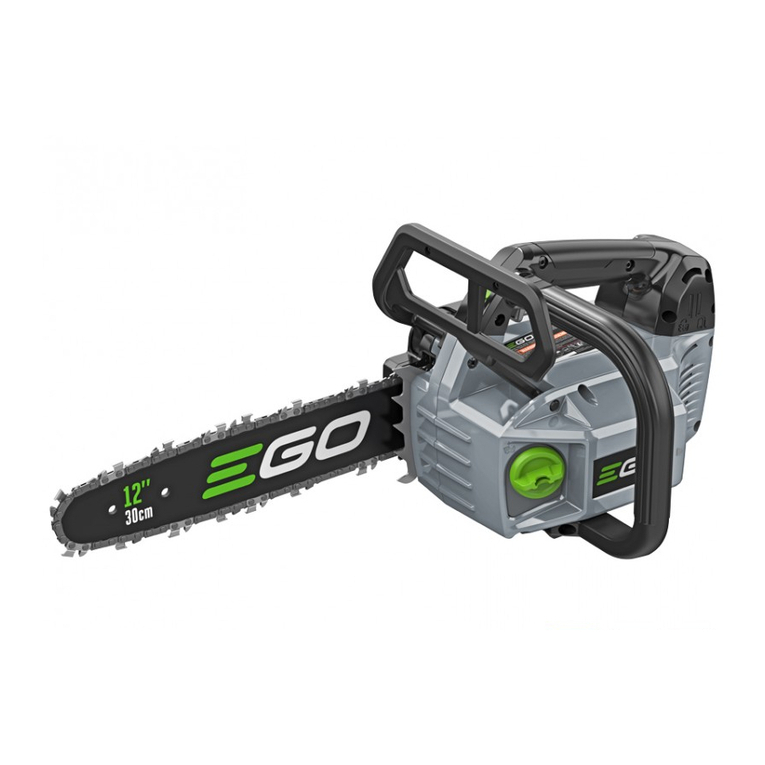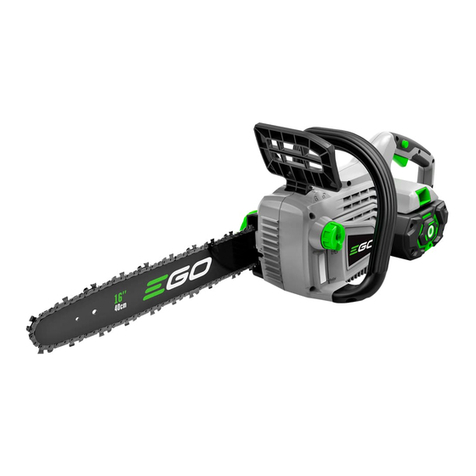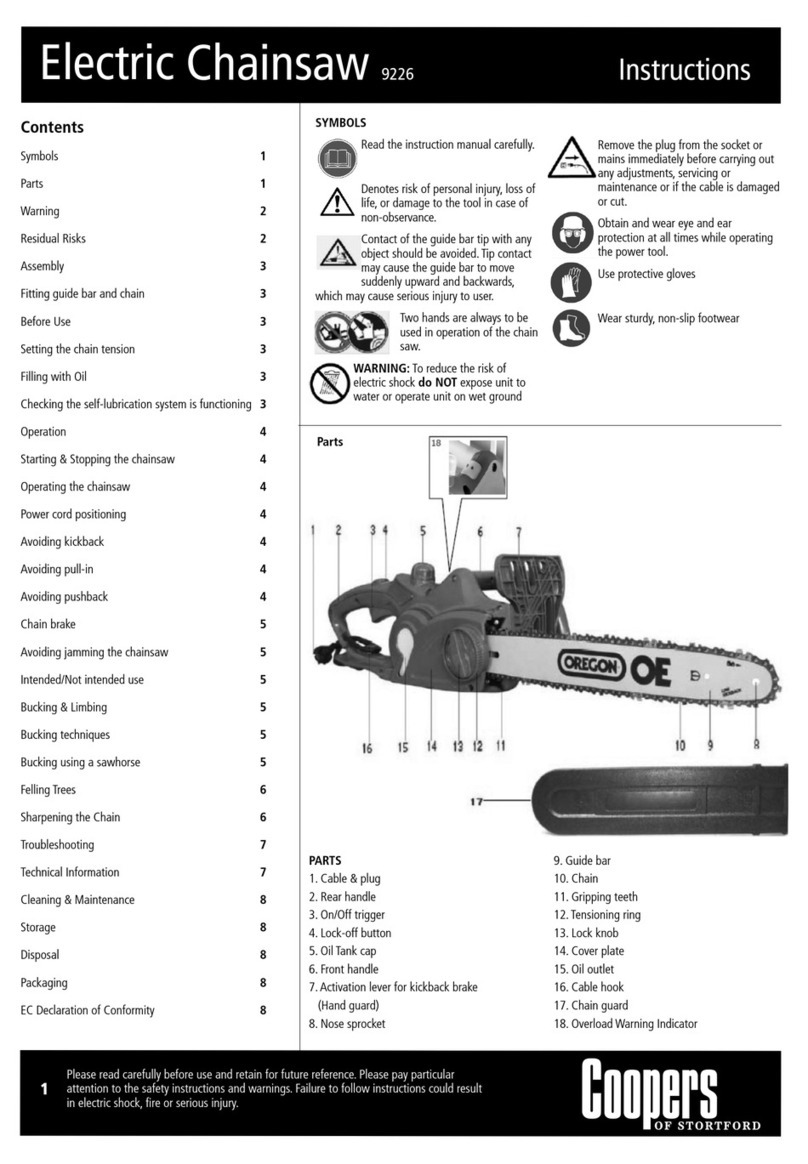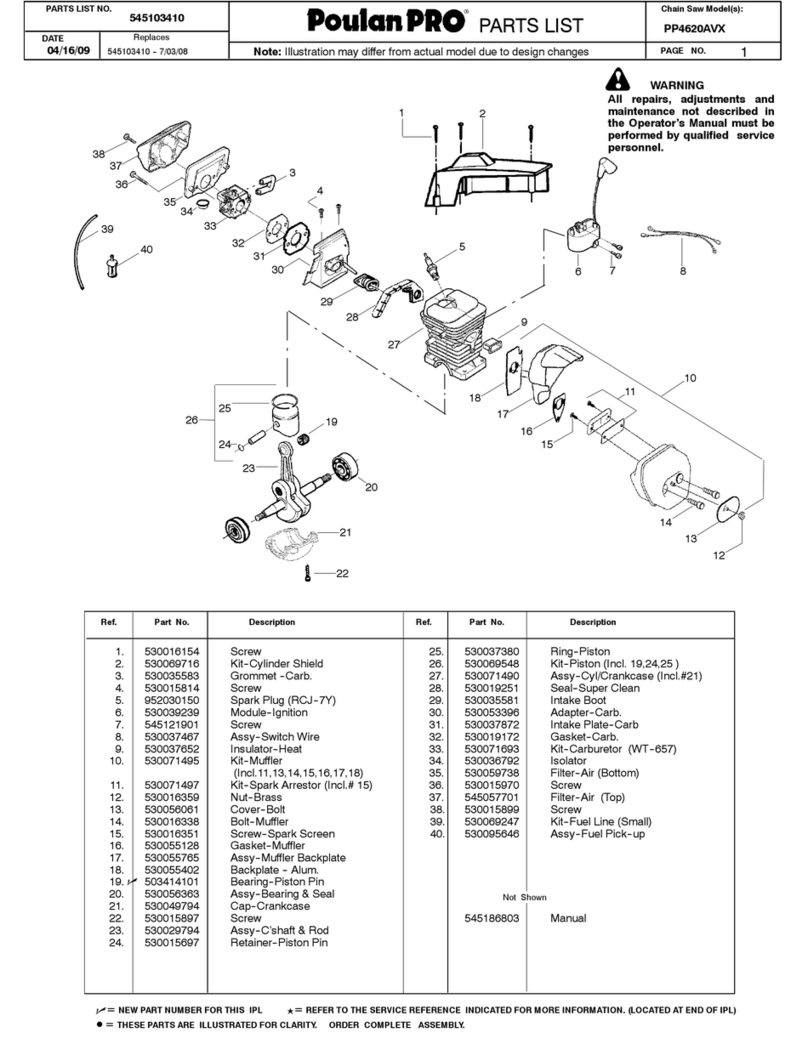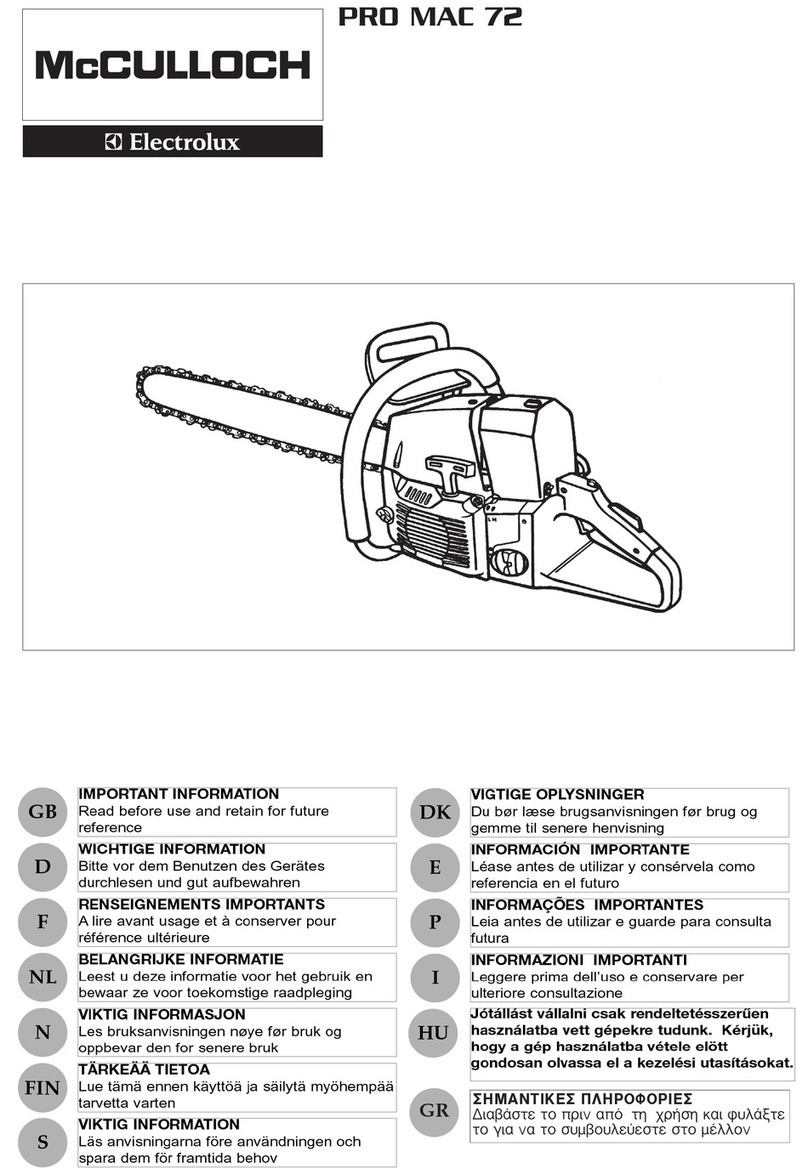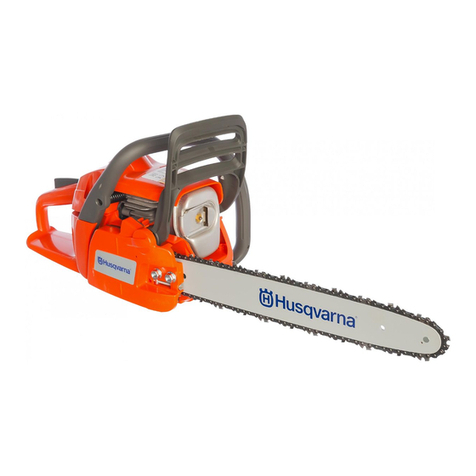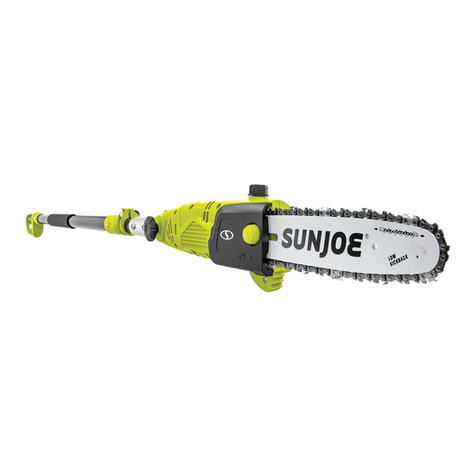EGO CS1400E User manual

WARNING: To reduce the risk of injury, the user must read and understand the
Operator’s Manual before using this product. Save these instructions for future reference.
OPERATOR’S MANUAL
56 VOLT LITHIUM-ION
CORDLESS CHAIN SAW
MODEL NUMBER CS1400E

B
D
C
E
7. Guide Bar
13. Front Handle
6. Saw Chain
5. Oil Inspection
Window
12. Chain Tensioning
Knob 9. Ejection Mechanism
8. Latch 10. Electric Contacts
4. Oil Tank Cap 3. Battery-release
Button
1. Trigger Switch
11. Chain Kickback
Brake Handle
20. Sprocket in
Guide Bar Tip
18. Chain
Sheath
2. Lock-off Button
14. Rear Handle
15. Chain Tensioning
Screw
16. Side Cover
Rotational kickback
Linear kickback
17. Side Cover Knob
A
19. Lubricating
Hole

F
H
J
L1
G
K
L2
I
Chain Tensioning Knob
Pull
Push
Chain kickback brake handle in operating position
Chain kickback brake handle
in brake position
Side Cover
Chain Drive
Links
Sprocket Tension
Adjusting Pin
Alignment Flange
Guide Bar Slot
Guide Bar Groove
Lift the Tip of the Guide
Bar Up to Check for Sag
Side Cover Knob

O
NM
P
Q
S
R
45°
T
1.3 mm
2
1
Felling direction
Safety retreat path Safety retreat path

V
W2
X
Y
U
W1
W3
50 mm
50 mm
1
1
2
2
Direction of fall
Felling back cut
Hinge
Notch

56 VOLT LITHIUM-ION CORDLESS CHAIN SAW — CS1400E6
EN
READ ALL INSTRUCTIONS!
READ & UNDERSTAND
INSTRUCTION MANUAL
Residual risk! People with electronic devices, such
as pacemakers, should consult their physician(s) before
using this product. Operation of electrical equipment
in close proximity to a heart pacemaker could cause
interference or failure of the pacemaker.
WARNING: To ensure safety and reliability, all
repairs and replacements should be performed by a
qualied service technician.
SAFETY SYMBOLS
The purpose of safety symbols is to attract your attention to
possible dangers. The safety symbols and the explanations
with them deserve your careful attention and understand-
ing. The symbol warnings do not, by themselves, eliminate
any danger. The instructions and warnings they give are no
substitutes for proper accident prevention measures.
WARNING: Be sure to read and understand all safety
instructions in this Operator’s Manual, including all safety
alert symbols such as “DANGER,” “WARNING,” and
“CAUTION” before using this tool. Failure to following all
instructions listed below may result in electric shock, re,
and/or serious personal injury.
SYMBOL MEANING
SAFETY ALERT SYMBOL: Indicates DANGER, WARN-
ING, or CAUTION. May be used in conjunction with other
symbols or pictographs.
WARNING: The operation of any
power tools can result in foreign objects
being thrown into your eyes, which can
result in severe eye damage. Before
beginning power tool operation, always
wear safety goggles or safety glasses with
side shields and a full face shield when
needed. We recommend a Wide Vision
Safety Mask for use over eyeglasses or
standard safety glasses with side shields.
SAFETY INSTRUCTIONS
This page depicts and describes safety symbols that may
appear on this product. Read, understand, and follow
all instructions on the machine before attempting to
assemble and operate.
Safety Alert Indicates a potential
personal injury hazard.
Read the
Operator’s
Manual
To reduce the risk of
injury, user must read
operator’s manual.
Wear Eye
Protection
Always wear safety gog-
gles or safety glasses
with side shields and
a full face shield when
operating this product.
Wear Ear
Protection
Always wear ear protec-
tion when operating this
product.
Wear Head
Protection
Wear an approved safety
hard hat to protect your
head.
Wear
Protective
Gloves
Protect your hands with
gloves when handling
saw and saw chain.
Heavy-duty, nonslip
gloves improve your grip
and protect your hands.
xxxxxxxxxx
xx mm
Guide Bar The information of guide
bar.
Be Aware
of Kickback
Contact of the guide
bar tip with any object
should be avoided
Guide
Bar Tip
Kickback
Tip contact can cause
the guide bar to move
suddenly upward and
backward, which can
cause serious injury.
Two Hand-
ed Hold
Always use two hands
when operating the
chain saw
IPX4
Ingress
Protection
Degree
Protection from splashing
water
V Volt Voltage
A Amperes Current
Hz Hertz Frequency
(cycles per second)
WWatt Power
min Minutes Time

56 VOLT LITHIUM-ION CORDLESS CHAIN SAW — CS1400E 7
EN
Alternating
Current Type of current
Direct
Current
Type or a characteristic
of current
n0
No Load
Speed
Rotational speed, at
no load
... /min Per Minute Revolutions per minute
GENERAL POWER TOOL SAFETY WARNINGS
WARNING: Read all safety warnings and
instructions. Failure to follow the warnings and instructions
may result in electric shock, re and/or serious injury.
Save all warnings and instructions for future
reference.
The term “power tool” in the warnings refers to your
mains-operated (corded) power tool or battery-operated
(cordless) power tool.
WORK AREA SAFETY
◾Keep work area clean and well lit. Cluttered or dark
areas invite accidents.
◾Do not operate power tools in explosive
atmospheres, such as in the presence of
ammable liquids, petrol or dust. Power tools create
sparks which may ignite the dust or fumes.
◾Keep children and bystanders away while operating a
power tool. Distractions can cause you to lose control.
ELECTRICAL SAFETY
◾Power tool plugs must match the outlet. Never
modify the plug in any way. Do not use any adaptor
plugs with earthed (grounded) power tools.
Unmodied plugs and matching outlets will reduce risk
of electric shock
◾Avoid body contact with earthed or grounded
surfaces, such as pipes, radiators, ranges and
refrigerators. There is an increased risk of electric
shock if your body is earthed or grounded.
◾Do not expose power tools to rain or wet
conditions. Water entering a power tool will increase
the risk of electric shock.
◾Do not abuse the cord. Never use the cord for
carrying, pulling or unplugging the power tool.
Keep cord away from heat, oil, sharp edges or
moving parts. Damaged or entangled cords increase
the risk of electric shock.
◾When operating a power tool outdoors, use an
extension cord suitable for outdoor use. Use of a cord
suitable for outdoor use reduces the risk of electric shock.
◾If operating a power tool in a damp location is
unavoidable, use a Ground-fault circuit interrupter
protected supply. Use of GFCI reduces the risk of
electric shock.
PERSONAL SAFETY
◾Stay alert, watch what you are doing and use
common sense when operating a power tool. Do
not use a power tool while you are tired or under
the inuence of drugs, alcohol, or medication. A
moment of inattention while operating power tools may
result in serious personal injury.
◾Use personal protective equipment. Always wear
eye protection. Protective equipment such as dust
mask, non-skid safety shoes, hard hat, or hearing
protection used for appropriate conditions will reduce
personal injuries.
◾Prevent unintentional starting. Ensure the switch
is in the off-position before connecting to power
source and/or battery pack, picking up or carrying
the tool. Carrying power tools with your nger on the
switch or energizing power tools that have the switch
on invites accidents.
◾Remove any adjusting key or wrench before
turning the power tool on. A wrench or a key left
attached to a rotating part of the power tool may result
in personal injury.
◾Do not overreach. Keep proper footing and balance
at all times. This enables better control of the power
tool in unexpected situations.
◾Dress properly. Do not wear loose clothing or
jewelry. Keep your hair, clothing and gloves away
from moving parts. Loose clothes, jewelry or long hair
can be caught in moving parts.
◾If devices are provided for the connection of dust
extraction and collection facilities, ensure these
are connected and properly used. Use of dust
devices can reduce dust-related hazards.
POWER TOOL USE AND CARE
◾Do not force the power tool. Use the correct power
tool for your application. The correct power tool will
do the job better and safer at the rate for which it was
designed.
◾Do not use the power tool if the switch does not
turn it on and off. Any power tool that cannot be
controlled with the switch is dangerous and must be
repaired.

56 VOLT LITHIUM-ION CORDLESS CHAIN SAW — CS1400E8
EN
◾Disconnect the plug from the power source and/or
the battery pack from the power tool before making
any adjustments, changing accessories, or storing
power tools. Such preventive safety measures reduce
the risk of starting the power tool accidentally.
◾Store idle power tools out of the reach of children
and do not allow persons unfamiliar with the
power tool or these instructions to operate the
power tool. Power tools are dangerous in the hands of
untrained users.
◾Maintain power tools. Check for misalignment or
binding of moving parts, breakage of parts and
any other condition that may affect the power
tool’s operation. If damaged, have the power tool
repaired before use. Many accidents are caused by
poorly maintained power tools.
◾Keep cutting tools sharp and clean. Properly
maintained cutting tools with sharp cutting edges are
less likely to bind and are easier to control.
◾Use the power tool, accessories and tool bits etc.
in accordance with these instructions, taking into
account the working conditions and the work to
be performed. Use of the power tool for operations
different from those intended could result in a
hazardous situation.
BATTERY TOOL USE AND CARE
◾Recharge only with the charger specied by the
manufacturer. A charger that is suitable for one type
of battery pack may create a risk of re when used
with another battery pack.
◾Use power tools only with specically designated
battery packs. Use of any other battery packs may
create a risk of injury and re.
◾When battery pack is not in use, keep it away from
other metal objects, like paper clips, coins, keys,
nails, screws or other small metal objects that can
make a connection from one terminal to another.
Shorting the battery terminals together may cause
burns or a re.
◾Under abusive conditions, liquid may be ejected
from the battery; avoid contact. If contact
accidentally occurs, ush with water. If liquid
contacts eyes, additionally seek medical help.
Liquid ejected from the battery may cause irritation
or burns.
SERVICE
◾Have your power tool serviced by a qualied repair
person using only identical replacement parts. This
will ensure that the safety of the power tool is maintained.
CHAIN SAW SAFETY WARNINGS
◾Keep all parts of the body away from the saw chain
when the chain saw is operating. Before you start
the chain saw, make sure the saw chain is not
contacting anything. A moment of inattention while
operating chain saws may cause entanglement of your
clothing or body with the chain.
◾Always hold the chain saw with your right hand
on the rear handle and your left hand on the front
handle. Holding the chain saw with a reversed hand
conguration increases the risk of personal injury and
should never be done.
◾Hold the power tool by insulated gripping surfaces
only, because the saw chain may contact hidden
wiring. Saw chains contacting a “live” wire may make
exposed metal parts of the power tool “live” and could
give the operator an electric shock.
◾Wear safety glasses and hearing protection.
Further protective equipment for head, hands,
legs and feet is recommended. Adequate protective
clothing will reduce personal injury by ying debris or
accidental contact with the saw chain.
◾Do not operate a chain saw in a tree. Operation of
a chain saw while up in a tree may result in personal
injury.
◾Always keep proper footing and operate the chain
saw only when standing on xed, secure and level
surface. Slippery or unstable surfaces such as ladders
may cause a loss of balance or control of the chain
saw.
◾When cutting a limb that is under tension be alert
for spring back. When the tension in the wood bers
is released the spring loaded limb may strike the
operator and/or throw the chain saw out of control.
◾Use extreme caution when cutting brush and
saplings. The slender material may catch the saw chain
and be whipped toward you or pull you off balance.
◾Carry the chain saw by the front handle with the
chain saw switched off and away from your body.
When transporting or storing the chain saw always
t the guide bar cover. Proper handling of the chain
saw will reduce the likelihood of accidental contact
with the moving saw chain.
◾Follow instructions for lubricating, chain
tensioning and changing accessories. Improperly
tensioned or lubricated chain may either break or
increase the chance for kickback.
◾Keep handles dry, clean, and free from oil and
grease. Greasy, oily handles are slippery causing loss
of control.

56 VOLT LITHIUM-ION CORDLESS CHAIN SAW — CS1400E 9
EN
◾Cut wood only. Do not use chain saw for purposes
not intended. For example: do not use chain saw
for cutting plastic, masonry or non-wood building
materials. Use of the chain saw for operations different
than intended could result in a hazardous situation.
CAUSES AND OPERATOR PREVENTION OF
KICKBACK (Fig. B, C, D & E)
Kickback may occur when the nose or tip of the guide
bar touches an object, or when the wood closes in
and pinches the saw chain in the cut.
Tip contact in some cases may cause a sudden
reverse reaction, kicking the guide bar up and back
towards the operator (Fig. B).
Pinching the saw chain along the top of the guide
bar may push the guide bar rapidly back towards the
operator (Fig. C).
Either of these reactions may cause you to lose con-
trol of the saw which could result in serious personal
injury. Do not rely exclusively upon the safety devices
built into your saw.
As a chain saw user, you should take several steps to
keep your cutting jobs free from accident or injury.
Kickback is the result of tool misuse and/or incorrect
operating procedures or conditions and can be avoided
by taking proper precautions as given below:
◾Maintain a rm grip, with thumbs and ngers
encircling the chain saw handles, with both hands on
the saw and position your body and arm to allow you
to resist kickback forces (Fig. E). Kickback forces can
be controlled by the operator, if proper precautions are
taken. Do not let go of the chain saw.
◾Do not overreach and do not cut above shoulder
height. This helps prevent unintended tip contact and
enables better control of the chain saw in unexpected
situations.
◾Only use replacement bars and chains specied
by the manufacturer. Incorrect replacement bars and
chains may cause chain breakage and/or kickback.
◾Follow the manufacturer’s sharpening and
maintenance instructions for the saw chain.
Decreasing the depth gauge height can lead to
increased kickback.
◾Make sure that the area in which you are cutting is
free from obstructions. Do not let the nose of the guide
bar contact a log, branch, fence, or any other obstruction
that could be hit while you are operating the saw.
◾Always cut with the unit running at full speed. Fully
squeeze the switch trigger and maintain cutting speed.
◾With a basic understanding of kickback, you can
reduce or eliminate the element of surprise. Sudden
surprise contributes to accidents.
◾Keep proper footing and balance at all times.
◾Push and Pull – The reaction force is always opposite
to the direction the chain is moving where wood contact
is made. Thus, the operator must be ready to control the
PULL when cutting on the bottom edge of the bar, and
the PUSH when cutting along the top edge (Fig. F).
KICKBACK SAFETY DEVICES ON THIS CHAIN SAW
Chain Brake
The chain saw comes equipped with a chain brake, which
stops both the motor and the motion of the chain when
kickback occurs. The chain brake can be activated by the for-
ward motion of the chain kickback brake handle as the saw
rotates backward during kickback; it can also be activated by
the inertial forces generated during rapid pushback.
WARNING: Never modify or attempt to disable the
chain brake.
Make sure that the chain brake is working properly before
using the chain saw. The chain kickback brake handle
should move back and forth easily.
To test the operation of the chain brake, perform the
following steps (Fig. G):
◾Place the chain saw on a at bare surface and make sure
no objects or obstructions that could come in contact
with the bar and chain are in the immediate vicinity.
◾Disengage the chain brake by pulling the chain
kickback brake handle towards the front handle.
◾Start the chain saw.
◾Push the chain kickback brake handle towards the front
of the saw. A properly functioning hand brake will stop the
movement of the chain immediately. If the chain brake is
not working properly, do not use the chain saw until it has
been repaired by a qualied service technician.
WARNING: Conrm that the chain brake works
properly before each use.
WARNING: If the chain brake is clogged with wood
chips, the function of the chain brake may deteriorate.
Always keep the device clean.
Low Kickback Saw Chain
The rakers (depth gauges) ahead of each cutter can
minimize the force of a kickback reaction by preventing the
cutters from digging in too deeply at the kickback zone.
Only use a replacement chain that is equivalent to the
original chain or has been certied one.

56 VOLT LITHIUM-ION CORDLESS CHAIN SAW — CS1400E10
EN
CAUTION: As saw chains are sharpened during their
useful life, they lose some of the low kickback qualities
and extra caution should be used.
ADDITIONAL WARNINGS
◾A chain saw is intended for two-handed use.
Serious injury to the operator, helpers, and/or
bystanders can result from one-handed operation.
◾Avoid unintentional contact with the stationary
saw chain or guide bar rails. These can be very
sharp. Always wear gloves and long pants or chaps
when handling the chain saw, saw chain, or guide bar.
◾Never operate a chain saw that is damaged or
improperly adjusted or that is not completely and
securely assembled. Be sure that the saw chain
stops moving when the trigger switch is released.
◾Inspect the work piece for nails, wire, or other
foreign objects prior to cutting.
◾When bucking, secure the work piece prior to
cutting. When felling or pruning, identify and
secure hazardous branches.
◾Aggressive or abusive cutting or misuse of the
chain saw can cause premature bar, chain, and/
or sprocket wear, as well as broken chain or bar,
leading to kickback, chain throw or the ejection of
material.
◾Never use the guide bar as a lever. A bent guide bar
can cause premature bar, chain, and/or sprocket wear,
as well as a broken chain or bar, leading to kickback,
chain throw or the ejection of material.
◾Cut only one work piece at a time.
◾Use only with EGO’s battery packs and chargers.
BATTERY CHARGER
BA1120E, BA1400, BA2240E,
BA2800, BA3360, BA4200
CH5500E,
CH2100E
◾Do not charge the battery pack in rain or in wet
locations.
◾Plan the work, ensuring an obstacle-free work area
and, in the case of felling, at least one escape path
from the falling tree.
◾When felling, keep bystanders at least two tree
lengths away.
◾If situations occur which are not covered in this
manual, use care and good judgment. Contact EGO
Customer Service for assistance.
GUIDE BAR
This saw comes equipped with a guide bar that has a
small radius nose. Small radius noses generally have less
potential for kickback. When replacing the guide bar, be
sure to order the bar listed in this manual.
SAVE THESE INSTRUCTIONS!
SPECIFICATIONS
Model CS1400E
Voltage 56 V
Guide Bar Length 350 mm
Chain Pitch 9.5 mm
Chain Gauge 1.1 mm
Saw Chain Type 90PX052X (Oregon)
Guide Bar Type 144MLEA041 (Oregon)
Chain Oil Tank Capacity 150 ml
Weight (without battery pack,
chain sheath) 3.81 Kg
PACKING LIST
PART NAME QUANTITY
Chain saw power head 1
Saw chain 1
Guide bar 1
Chain sheath 1
Operator’s manual 1
DESCRIPTION
KNOW YOUR CHAIN SAW (Fig. A)
1. Trigger Switch
2. Lock-off Button
3. Battery-release Button
4. Oil Tank Cap
5. Oil Inspection Window
6. Saw Chain
7. Guide Bar
8. Latch

56 VOLT LITHIUM-ION CORDLESS CHAIN SAW — CS1400E 11
EN
9. Ejection Mechanism
10. Electric Contacts
11. Chain Kickback Brake Handle
12. Chain Tensioning Knob
13. Front Handle
14. Rear Handle
15. Chain Tensioning Screw
16. Side Cover
17. Side Cover Knob
18. Chain Sheath
19. Lubricating Hole
20. Sprocket in Guide Bar Tip
NOTICE: The chain kickback brake handle services as the
lever for chain brake activation. It also provides protection
against projecting branches and helps prevent the left hand
from touching the saw chain if it slips off the front handle.
ASSEMBLY
WARNING: If any parts are damaged or missing,
do not operate this product until the parts are replaced.
Use of this product with damaged or missing parts could
result in serious personal injury.
WARNING: Do not attempt to modify this product
or create accessories not recommended for use with this
chain saw. Any such alteration or modication is misuse
and could result in a hazardous condition leading to
possible serious personal injury.
WARNING: To prevent accidental starting that could
cause serious personal injury, always remove the battery
pack from the tool when assembling parts.
ASSEMBLING/REPLACING THE BAR AND CHAIN
WARNING: Always wear gloves when handling the
bar and chain; these components are sharp and may
contain burrs.
1. Position the chain saw power head on its side with
the side cover facing upwards (Fig. H).
2. Turn the side cover knob counterclockwise to remove
the side cover and then loosen the chain tensioning
knob as much as possible.
3. Lay the new saw chain in a loop on a at surface and
straighten any kinks (Fig. I).
4. Place the chain drive links into the guide bar groove
and make the chain a loop at the back of the guide
bar (Fig. J).
5. Hold the chain in position on the guide bar and place
the loop around the sprocket of the power head.
6. Slide the guide bar slot over the alignment anges
until the tension adjusting pin is inserted in the lower
hole in the tail of the bar (Fig. L1).
NOTICE: Small directional arrows are engraved in the
saw chain. Another directional arrow is molded into the
housing. When looping the saw chain onto the sprocket,
make sure that the direction of the arrows on the saw
chain will correspond to the direction of the arrow on the
housing. If they face in opposite directions, turn over the
saw chain and guide bar assembly (Fig. L2).
7. Replace the side cover and slightly tighten the side
cover knob.
8. Lift the tip of the guide bar up to check for sag
(Fig. K). Release the tip of the guide bar and turn the
chain tensioning knob clockwise. Repeat this process
until the sag is eliminated.
9. Tighten the side cover knob securely to ensure that
the saw chain is properly tensioned before using.
NOTICE: To extend the guide bar life, invert the bar
occasionally.
NOTICE: If chain is too tight, it will not rotate. Loosen
the side cover knob slightly and turn the tensioning knob
once from right to left. Lift the tip of the guide bar up and
retighten the side cover knob securely. Assure that the
chain will rotate without binding.
ADJUSTING THE CHAIN TENSION
◾Stop the motor and remove the battery pack before
adjusting the chain tension. Make sure the side
cover knob is loosened. Turn the chain tensioning
knob clockwise to tension the chain. See the section:
“REPLACE THE BAR AND CHAIN” for additional
information.
◾A cold chain is correctly tensioned when there is no slack
on the underside of the guide bar and the chain is snug, but
it can be turned by hand without binding. The chain must
be re-tensioned whenever the ats on the drive links do not
sit in the bar groove.
◾During normal saw operation, the temperature of
the chain will increase. The drive links of a correctly
tensioned warm chain will hang approximately 1.3 mm
out of the bar groove (Fig. M).
NOTICE: New chains tend to stretch; check chain tension
frequently and tension as required.
NOTICE: A chain tensioned while it is warm may be too
tight upon cooling. Check the cold tension before next use.

56 VOLT LITHIUM-ION CORDLESS CHAIN SAW — CS1400E12
EN
OPERATION
WARNING: Do not allow familiarity with this product
to make you careless. Remember that a careless fraction
of a second is sufcient to inict serious injury.
WARNING: Always wear eye protection with side
shields. Failure to do so could result in objects being
thrown into your eyes and other possible serious injuries.
WARNING: Do not use any attachments or
accessories not recommended by the manufacturer of
this product. The use of attachments or accessories not
recommended can result in serious personal injury.
WARNING: To prevent accidental starting that could
cause serious personal injury, always remove the battery
pack from the tool when assembling parts, making
adjustments, cleaning, or when not in use.
Before each use, inspect the entire product for damaged,
missing, or loose parts, such as screws, nuts, bolts, caps, etc.
Securely tighten all fasteners and caps and do not operate
this product until all missing or damaged parts are replaced.
APPLICATION
You may use this product for basic felling, limbing, prun-
ing and woodcutting of timber and trees.
NOTICE: The tool is to be used only for its prescribed
purpose. Any other use is deemed to be a case of misuse.
FILLING BAR AND CHAIN LUBRICANT
WARNING: Do not smoke or bring any re or ame
near the oil or the chain saw. Oil may spill and cause
a re.
NOTICE: The chain saw is not lled with oil at the time of
purchase. It is essential to ll the tank with oil before use.
The chain is automatically lubricated with chain oil during
operation.
1. Position the chain saw on its side with its oil tank cap
facing towards.
2. Clean the cap as well as the area around and then turn it
counterclockwise to remove (Fig. N).
3. Carefully pour the specically designed oil into the
tank until reaching the bottom of the lter neck.
4. Wipe off any excessive oil and replace the cap.
NOTICE: With upright position, oil should ll the
inspection window. When the oil is no longer visible in the
inspection window, stop use immediately and rell.
ATTACHING/DETACHING THE BATTERY PACK
Fully charge before rst use.
To Attach (Fig. O)
Align the battery ribs with the mounting slots and press
the battery pack down until you hear a “click”.
To Detach (Fig. P)
Depress the battery-release button and pull the battery
pack out.
STARTING/STOPPING THE CHAIN SAW
NOTICE: Before starting the chain saw, check for the oil
level, saw teeth sharpness and properly-working kickback
brake handle. Besides, balanced footing and proper
distance away from the ground are needed.
To Start
1. Pull the chain kickback brake handle towards the
front handle to the operating position (Fig. G).
2. Grasp the front and rear handles rmly, using
both hands.
3. Press down the lock-off button rst, then squeeze
the trigger switch to start (Fig. Q). Release the lock-
off button and continue to squeeze the trigger for
continued operation.
WARNING: Do not attempt to start the saw when the
saw chain is in a cut.
To Stop
1. Release the trigger switch.
2. Push the chain kickback brake handle forward to the
brake position to engage the chain brake (Fig. G).
WARNING: Always remove the battery pack from the
chain saw during work breaks and after nishing work.
Proper Grip On Handles (Fig. E)
◾Wear non-slip gloves for maximum grip and protection.
◾With the saw on a rm, at surface, hold the saw
rmly with both hands.
◾Always grasp the front handle with the left hand and
the rear handle with the right.
◾The ngers should encircle the handle, with the
thumb wrapped under the front handle.
WARNING: Never use a left-handed (cross-handed)
grip, or any stance which would place your body or arm
across the chain line (Fig. R).

56 VOLT LITHIUM-ION CORDLESS CHAIN SAW — CS1400E 13
EN
Proper Cutting Stance (Fig. S)
◾Both feet should be on solid ground, with weight evenly
spread between them.
◾The left arm should be straight, with the elbow locked.
This helps to withstand the forces generated by
kickback.
◾Your body should always be to the left of the chain line.
INSTRUCTIONS CONCERNING THE PROPER
TECHNIQUES FOR BASIC FELLING, LIMBING, AND
CROSS-CUTTING
WARNING: Always be sure of your footing and hold the
chain saw rmly with both hands while the motor is running.
WARNING: When the saw chain is stopped due
to pinching during cutting, release the trigger switch;
remove the saw chain and guide bar from the wood, then
restart the chain saw.
WARNING: Do not pull the saw chain with hand
when it is bound by the sawdust. Serious injury could
result if the chain saw starts accidentally. Press the saw
chain against the wood, move the chain saw back and
forth to discharge the debris. Always remove the battery
pack before cleaning. Wear heavy protective gloves when
handling the saw chain.
WARNING: Never start the chain saw when it is in
contact with the wood. Always allow the chain saw reach
full speed before applying the saw to the wood.
Felling a tree
◾When bucking and felling operations are being
performed by two or more persons at the same time,
the felling operation should be separated from the
bucking operation by a distance of at least twice the
height of the tree being felled. Trees should not be
felled in a manner that would endanger any person,
strike any utility line or cause any property damage.
If the tree does make contact with any utility line, the
utility company should be notied immediately.
◾The chain saw operator should stand on the uphill
side of the terrain, as the tree is likely to roll or slide
downhill after it is felled.
◾An escape path should be planned and cleared as
necessary before cuts are started. The escape path
should extend back and diagonally to the rear of the
expected line of fall as Fig. T shown.
◾Before felling is started, consider the natural lean of
the tree, the location of larger branches and the wind
direction to judge which way the tree will fall.
◾Remove dirt, stones, loose bark, nails, staples and wire
from the tree.
Notching undercut
Make the notch 1/3 the diameter of the tree, perpendic-
ular to the direction of falls as Fig. U shown. Make the
lower horizontal notching cut rst. This will help to avoid
pinching either the saw chain or the guide bar when the
second notch is being made.
Felling back cut
◾Make the felling back cut at least 50 mm higher than
the horizontal notching cut as Fig. U shown. Keep the
felling back cut parallel to the horizontal notching cut.
Make the felling back cut so enough wood is left to
act as a hinge. The hinge wood keeps the tree from
twisting and falling in the wrong direction. Do not cut
through the hinge.
◾As the felling gets close to the hinge, the tree should
begin to fall. If there is any chance that the tree may
not fall in desired direction or it may rock back and
bind the saw chain, stop cutting before the felling back
cut is complete and use wedges of wood, plastic or
aluminium to open the cut and drop the tree along the
desired line of fall.
◾When the tree begins to fall remove the chain saw
from the cut, stop the motor, put the chain saw
down, then use the retreat path planned. Be alert for
overhead limbs falling and watch your footing.
Limbing a tree
Limbing is removing the branches from a fallen tree.
When limbing leave larger lower limbs to support the
log off the ground. Remove the small limbs in one cut as
Fig. V shown. Branches under tension should be cut from
the bottom up to avoid binding the chain saw.
Bucking a log
◾Bucking is cutting a log into lengths. It is important to
make sure your footing is rm and your weight is evenly
distributed on both feet. When possible, the log should
be raised and supported by the use of limbs, logs or
chocks. Follow the simple directions for easy cutting.
◾When the log is supported along its entire length as
Fig. W1 shown, it is cut from the top (overbuck).
◾When the log is supported on one end, as Fig. W2
shown, cut 1/3 the diameter from the underside
(underbuck). Then make the nished cut by
overbucking to meet the rst cut.

56 VOLT LITHIUM-ION CORDLESS CHAIN SAW — CS1400E14
EN
◾When the log is supported on both ends, as Fig. W3
shown, cut 1/3 the diameter from the top (overbuck).
Then make the nished cut by underbucking the lower
2/3 to meet the rst cut.
◾When bucking on a slope always stand on the uphill
side of the log, as Fig. X shown.
◾When “cutting through”, to maintain complete control
release the cutting pressure near the end of the cut
without relaxing your grip on the chain saw handles.
Don’t let the chain contact the ground. After completing
the cut, wait for the saw chain to stop before you move
the chain saw. Always stop the motor before moving
from tree to tree.
MAINTENANCE
WARNING: When servicing, use only identical
replacement parts. Use of any other parts may create a
hazard or cause product damage.
WARNING: Always wear protective gloves when
performing any maintenance to the chain saw.
WARNING: To avoid serious personal injury, remove
the battery pack from the chain saw before inspecting,
cleaning, or performing maintenance. A battery operated
tool with the battery pack inserted is always on and can
start accidently.
WARNING: When cleaning the chain saw, DO NOT
immerse in water or other liquids.
WARNING: Do not at any time let brake uids, petrol,
petroleum-based products, penetrating oils, etc., come in
contact with plastic parts. Chemicals can damage, weaken,
or destroy plastic, which may result in serious personal
injury.
CLEANING
◾After each use, clean debris from the chain and guide
bar with a soft brush. Wipe the chain saw surface with
a clean cloth moistened with a mild soap solution.
◾Remove the side cover, and then use a soft brush to
remove debris from the guide bar, saw chain, sprocket
and side cover.
◾Always clean out wood chips, saw dust, and dirt from
the guide bar groove when replacing the saw chain.
REPLACING THE BAR AND CHAIN
WARNING: Never touch or adjust the chain while the
motor is running. The saw chain is very sharp.
NOTICE: When replacing the guide bar and chain, always
use the specied bar and chain combination listed in the
manual.
Disassemble the Worn Bar and Chain (Fig. Y)
1. Remove the battery, allow the saw to cool and tighten
the oil tank cap.
2. Position the chain saw on its side with the side cover
facing upwards.
3. Wear gloves. Remove the side cover by turning the
side cover knob counterclockwise. Clean the side
cover with a dry cloth.
NOTICE: This is a good time to inspect the drive sprocket for
excessive wear or damage.
Assemble The New Bar And Chain
Follow the instructions in the ASSEMBLING/REPLACING
THE BAR AND CHAIN section in this manual.
Adjust The Chain Tension
Follow the instructions in the ADJUSTING THE CHAIN
TENSION section in this manual.
CHAIN MAINTENANCE
WARNING: Always wear gloves when handling the
saw chain; these components are sharp and may contain
burrs.
Use only low-kickback chains on this saw. This fast cut-
ting chain will provide kickback reduction when properly
maintained.
A properly sharpened saw chain cuts through wood effortless-
ly, even with very little pressure.
Never use a dull or damaged saw chain. A dull saw chain
cutter leads to increased physical strain, increased vibration
load, unsatisfactory cutting results and increased wear.
For smooth and fast cutting, the chain needs to be
maintained properly. The chain requires sharpening when
the wood chips are small and powdery, the chain must be
forced through the wood during cutting, or the chain cuts
to one side. During maintenance of your chain, consider
the following:

56 VOLT LITHIUM-ION CORDLESS CHAIN SAW — CS1400E 15
EN
◾Improper ling angle of the side plate can increase the
risk of a severe kickback.
◾Raker (depth gauge) clearance. Too low increases
the potential for kickback. Not low enough decreases
cutting ability.
◾If cutter teeth have hit hard objects, such as nails and
stones, or have been abraded by mud or sand on the
wood, have the chain sharpened by a qualied service
technician.
NOTICE: Inspect the drive sprocket for wear or damage
when replacing the chain. If signs of wear or damage are
present in the areas indicated, have the drive sprocket
replaced by qualied service technician.
GUIDE BAR MAINTENANCE
When the guide bar shows signs of wear, reverse it on
the saw to distribute the wear for maximum bar life. The
bar should be cleaned every day of use and checked for
wear and damage. Feathering or burring of the bar rails
is a normal process of bar wear. Such faults should be
smoothed with a le as soon as they occur. A bar with any
of the following faults should be replaced.
◾Wear inside the bar rails which permits the chain to lay
over sideways.
◾Bent guide bar.
◾Cracked or broken rails.
◾Spread rails.
In addition, the guide bar has a sprocket at its tip. The
sprocket must be lubricated weekly with a grease syringe
to extend the guide bar life. Use a grease syringe to
lubricate weekly with chain oil by means of the lubricating
hole. Turn the guide bar and check that the lubrication
holes and chain groove are free from impurities.
TRANSPORTING AND STORING
◾Do not store or transport the chain saw when it is
running. Always remove the battery pack before
storing or transporting.
◾Always place the guide bar sheath on the guide bar
and chain before storing or transporting the chain saw.
Use caution to avoid the sharp teeth of the chain.
◾Clean the chain saw thoroughly before storing. Store
the chain saw indoors, in a dry place that is locked
and/or inaccessible to children.
◾Keep away from corrosive agents such as garden
chemicals and de-icing salts.
Protecting the environment
Do not dispose of electrical appliances
as unsorted municipal waste, use
separate collection facilities.
Contact your local government for
information regarding the collection
systems available.
If electrical appliances are disposed of in
landlls or dumps, hazardous substances
can leak into the groundwater and get
into the food chain, damaging your health
and well-being.

56 VOLT LITHIUM-ION CORDLESS CHAIN SAW — CS1400E16
EN
TROUBLESHOOTING
WARNING: Always protect your hands by wearing heavy gloves when performing any maintenance on the saw
chain. Always remove the battery pack when servicing or transporting the chain saw.
PROBLEM CAUSE SOLUTION
Motor does not run
◾The battery pack is not attached to
the chain saw.
◾Attach the battery pack to the chain saw.
◾There is no electrical contact between
the saw and battery.
◾Remove the battery, check contacts and reinstall
the battery pack.
◾The battery pack is depleted. ◾Charge the battery pack.
◾The battery pack or chain saw is
too hot.
◾Allow the battery pack or chain saw to cool until
the temperature drops below 67°C.
◾The lock-off button is not depressed
before pressing the trigger switch.
◾Press down the lock-off button and hold it, then
depress the trigger switch to turn on the chain
saw.
◾Chain brake is engaged. ◾Pull the chain kickback brake handle backward
toward the front handle.
◾Saw chain is bound in the wood. ◾Release the trigger switch; remove the saw chain
and guide bar from the wood, then restart the
chain saw.
◾Debris in bar groove. ◾Press the saw chain against the wood, move
the chain saw back and forth to discharge the
debris.
◾Debris in side cover. ◾Remove battery pack, then remove side cover
and clean out debris.
Motor runs, but chain
does not rotate
◾Chain does not engage drive sprocket. ◾Reinstall the chain, making sure that the drive
links on the chain are fully seated on the
sprocket.
Chain brake does not
engage
◾Debris preventing full movement of
the chain kickback brake handle.
◾Clean debris from external chain brake
mechanism.
◾Possible chain brake malfunction ◾Contact EGO Customer Service.

56 VOLT LITHIUM-ION CORDLESS CHAIN SAW — CS1400E 17
EN
PROBLEM CAUSE SOLUTION
Chain saw does not cut
properly
◾Insufcient chain tension. ◾Readjust the chain tension, following the section:
“ADJUSTING THE CHAIN TENSION”.
◾Dull chain. ◾Sharpen the chain cutters.
◾Chain installed backwards. ◾Reinstall the saw chain, following the section:
“REPLACE THE BAR AND CHAIN”.
◾Worn chain. ◾Replace the chain, following the section:
“REPLACE THE BAR AND CHAIN”.
◾Dry or excessively stretched chain. ◾Check the oil level. Rell the oil tank if necessary.
◾Chain not in bar groove. ◾Reinstall the saw chain, following the section:
“REPLACE THE BAR AND CHAIN”.
Bar and chain running
hot and smoking
◾Check chain tension for over
tightened condition.
◾Re-tension the saw chain; see the section:
“ADJUSTING THE CHAIN TENSION”.
◾Chain oil tank is empty. ◾Filling bar and chain lubricant.
◾Debris in guide bar groove. ◾Clear the debris in the groove.

56 VOLT LITHIUM-ION CORDLESS CHAIN SAW — CS1400E18
EN
WARRANTY
EGO WARRANTY POLICY
5 year warranty on EGO outdoor power equipment and 3 year warranty on EGO Power+ System battery packs and
chargers.
Please contact EGO customer service on Australia 1300 000 EGO(1300 000 346),
New Zealand 0508 000 EGO (0508 000 346) any time you have questions or warranty claims.
LIMITED SERVICE WARRANTY
FOR FIVE YEARS from the date of original retail purchase, this EGO product is warranted against defects in material or
workmanship. Defective product will receive free repair.
FOR THREE YEARS from the date of original retail purchase, the EGO Power+ System battery pack and charger are
warranted against defects in material or workmanship. Defective product will receive free repair.
This warranty does not cover routine maintenance parts and consumables that can wear out from normal use within the
warranty period.
◾This warranty applies only to the original purchaser at retail and may not be transferred.
◾The warranty period for any EGO product or part used for industrial, professional or commercial purpose is one year.
◾This warranty is void if the product has been used for rental purpose.
◾This warranty does not cover the damage resulting from modication, alteration or unauthorized repair.
◾This warranty only covers defects arising under normal usage and does not cover any malfunction, failure or defect
resulting from misuse, abuse (including overloading of the product beyond capacity and exposure to water or rain),
accidents, neglect or lack of proper installation, and improper maintenance or storage.
◾This warranty does not cover normal deterioration of the exterior nish, including but not limited to scratches, dents,
paint chips, or to any corrosion or discoloring by heat, abrasive and chemical cleaners.
HOW TO OBTAIN SERVICE
For warranty service, please contact EGO customer service on Australia 1300 000 EGO(1300 000 346),
New Zealand 0508 000 EGO (0508 000 346). When requesting warranty service, you must present the original dated
sales receipt. An authorized service center will be selected to repair the product according to the stated warranty terms.
ADDITIONAL LIMITATIONS
Chervon Australia Pty Ltd ABN 36 165 077 501(“Chervon”) warrants to the original domestic purchaser that this
product will be free from defects in materials and workmanship for 5 years from date of purchase, and any battery or
charger will be free from defects in materials and workmanship for 3 years from date of purchase. To make a claim,
return the faulty item together with proof of purchase directly to your closest service agent or to the place of purchase.
Any handling and transportation costs (and other expenses incurred in claiming this warranty) are not covered by this
warranty and will not be borne by Chervon. The replacement product or part or repaired product will be made available
for your collection at an address nominated by Chervon. Where a valid warranty claim is made, Chervon will replace the
defective product or repair the fault. Where the product is repaired, Chervon may use refurbished parts. This warranty
does not cover normal wear and tear, misuse or abuse. This warranty may also be further limited or voided as speci-
cally detailed in the product Manual. Chervon has no other liability under this warranty.The benets to you given by this
warranty are in addition to other rights and remedies imposed by State and Federal legislation that cannot be excluded.
Our goods come with guarantees that cannot be excluded under the Australian Consumer Law. You are entitled to a
replacement or refund for a major failure and compensation for any other reasonably foreseeable loss or damage. You
are also entitled to have the goods repaired or replaced if the goods fail to be of acceptable quality and the failure does
not amount to a major failure. Chervon Australia Pty Ltd, Unit 13, 1488 Ferntree Gully Rd, Knoxeld, VIC. 3180.
Phone Number: Australia 1300 000 EGO(1300 000 346), New Zealand 0508 000 EGO (0508 000 346).


Other manuals for CS1400E
5
Table of contents
Other EGO Chainsaw manuals
Popular Chainsaw manuals by other brands
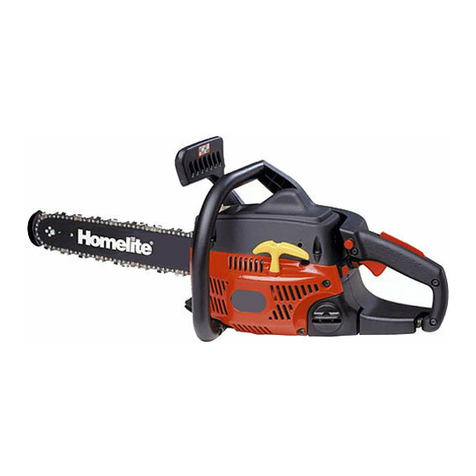
Homelite
Homelite UT10530A Operator's manual

Makita
Makita DCS 330 TH Owner's and safety manual

McCulloch
McCulloch MS1846AV parts list
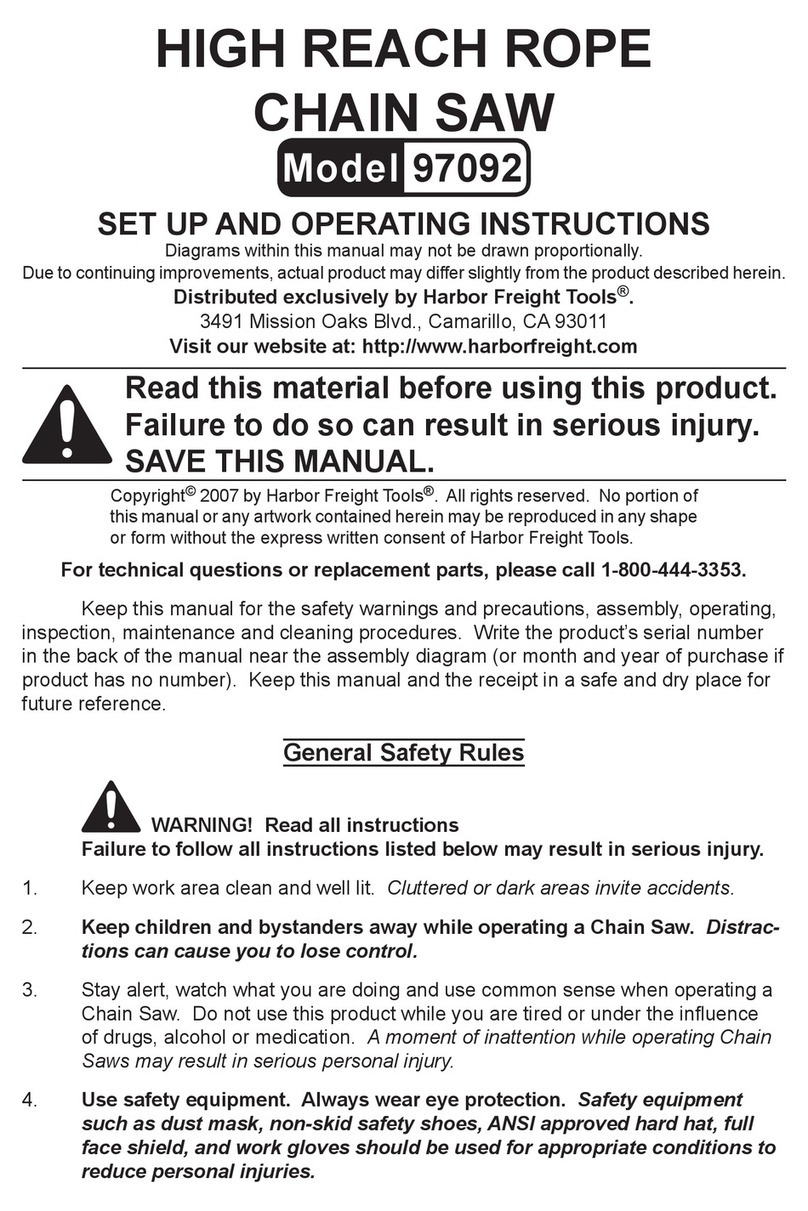
Harbor Freight Tools
Harbor Freight Tools 97092 Set up and operating instructions
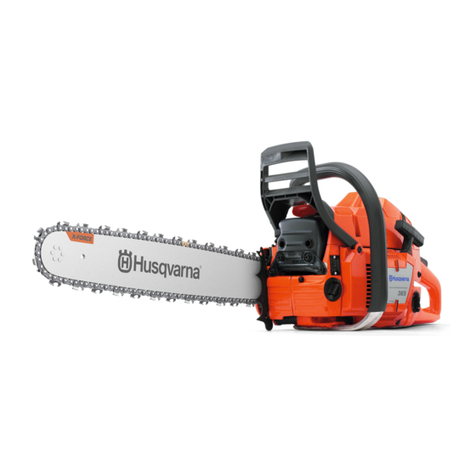
Husqvarna
Husqvarna 365 X-Torq Workshop manual
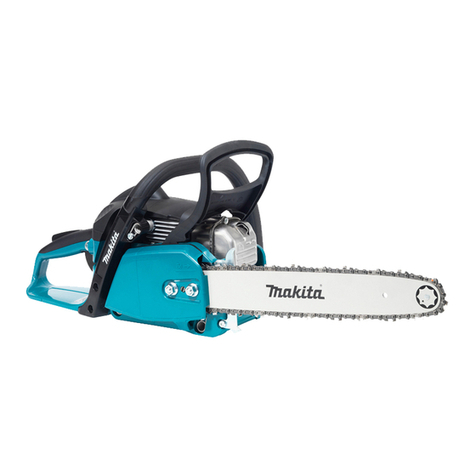
Makita
Makita EA3500S Original instruction manual
